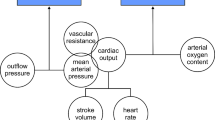Summary
Oxygen consumption, hemodynamics, and regional blood flow (with the radioactive microspheres technique) were determined in 12 anesthetized dogs subjected to hemorrhagic shock. The animals were kept in hypotension at 40 mm Hg, until 15% of the maximum shed blood had been infused to keep arterial pressure stable, whereafter all the shed blood was retransfused. Cardiac output (CO) decreased to 33% and 25% of preshock values in survivors (S) and nonsurvivors (NS), respectively, and after retransfusion it was significantly higher in S. After retransfusion, NS showed a higher arterial pCO2 than S adding a respiratory component to the metabolic acidosis that occurred during and after hemorrhage. Blood flow to the brain was not impeded during shock, but as CO decreased the fraction delivered to the brain was increased 2.6–3.3-fold. Myocardial blood flow decreased to about 28% of preshock values immediately after hemorrhage, and increased to about 54% at the end of hemorrhage. After retransfusion S had a higher myocardial flow than NS. The flow to the gut paralleled the decrease in CO during hemorrhage and immediately after retransfusion NS exhibited an overperfusion in ileum and colon compared to the preshock values. Kidney blood flow fell progressively during the course of hypotension, similarly in S and NS. After retransfusion it was normalized in S but not in NS. The preshock flow to pancreas was significantly higher in S than in NS, but during and after shock the blood flow did not differ between S and NS.
Similar content being viewed by others
References
Appelgren KL, Lewis DH (1972) Capillary flow and capillary transport in dog skeletal muscle in hemorrhagic shock. Eur Surg Res 4:29–36
Carrière S, Thornburn GD, O'Morchoe CC, Barger AC (1966) Intrarenal distribution of blood flow in dogs during hemorrhagic hypotension. Circ Res 19:167–179
Cassuto J, Cedgard S, Haglund U, Redfors S, Lundgren O (1979) Intramural blood flows and flow distribution in the feline small intestine during arterial hypotension. Acta Physiol Scand 106:335–342
Cobb FR, Bache RJ, Greenfield JC (1974) Regional myocardial blood flow in awake dogs. J Clin Invest 53:1618–1625
Crowell JW (1970) Oxygen transport in the hypotensive state. Fed Proc 29:1848–1853
Domenech RJ, Hoffman JIE, Noble MI (1969) Total and regional coronary blood flow measured by radioactive microspheres in conscious and anesthetized dogs. Circ Res 25:581–596
Folkow B (1962) Nervous adjustment of the vascular bed with special reference to patterns of vasoconstrictor discharge. In Bock KD (ed) Shock, pathogenesis, and therapy. Int Symp, Stockholm, June 1961. Springer, Berlin Heidelberg New York, pp 61–72
Granger DN, Rutili G, McCord J (1981) Superoxide radicals in feline intestinal ischemia. Gastroenterology 81:22–29
Greenway CV, Larsson AE (1966) The effect of hemorrhage on venous and regional blood flow in the anesthetized cat. J Physiol (Lond) 184:856–871
Haglund U, Hultén L, Lundgren O, Åhrén C (1975) Mucosal lesions in the human small intestine in shock. Gut 16:979–984
Haglund U, Lundgren O (1978) Intestinal ischemia and shock factors. Fed Proc 37:2729–2733
Haglund U, Tetsuo A, Åhrén C (1976) The intestinal mucosal lesions in shock. Eur Surg Res 8:448–460
Heyman MA, Payne BD, Hoffman JI, Rudolph AM (1977) Blood flow measurements with radionuclide-labeled particles. Prog Cardiovasc Dis 20:55–79
Lefer AM (1970) Role of a myocardial depressant factor in the pathogenesis of circulatory shock. Fed Proc 29:1836–1842
Lundberg C, Schoenberg MH (1985) Comparison of the Fick principle and the radioactive microsphere method in measuring cardiac output during hemorrhagic shock. Acta Physiol Scand 123:293–297
Lundsgaard-Hansen P, Meyer C, Riedmyl A (1968) Transmural gradients of glycolytic enzyme activities in left ventricular myocardium. II. Prolonged hemorrhagic hypotension. Pflügers Arch 301:144–161
Parks DA, Bulkley GD, Granger DN, Hamilton SK, McCord JM (1982) The ischemic injury of the cat small intestine: Role of superoxide radicals. Gastroenterology 82:9–15
Porciuncula CI, Crowell JW (1963) Quantitative study of intestinal fluid loss in irreversible shock. Am J Physiol 205:261–268
Schoenberg MH, Muhl E, Sellin D, Schildberg FW, Younes M, Haglund U (1984) Posthypotensive generation of superoxide free radicals—possible role in the pathogenesis of the intestional mucosal damage. Acta Chir Scand 150:301–309
Schoenberg MH, Smedegård G, Gerdin B, Messmer K, Arfors K-E (1985) Hemorrhagic shock in dogs. I. Correlation between survival and severity of shock. Res Exp Med (Berl) 185:21–33
Schosser R, Arfors K-E, Messmer K (1979) MIC-II—a program for the determination of cardiac output, arterio-venous shunt, and regional blood flow using the radioactive microsphere method. Comp Prog Biomed 9:19–38
Slater GI, Vladeck BC, Bassin R, Kark AE, Shoemaker WC (1975) Sequential changes in distrtibution of cardiac output in hemorrhagic shock. Surgery 5:714–722
Slotkoff LM, Logan A, Jose P, D'Avella J, Eisner GM (1971) Microsphere measurements of intrarenal circulation of the dog. Circ Res 28:158–166
Spitzer JJ, Spitzer JA, Weng JT, Scott JC (1972) Myocardial metabolism during acute hemorrhage and endotoxic shock. Adv Exp Med Biol 23:267–273
Tschelks TH, Klassen AC, Resch JA, Meys NN (1970) Blood flow in the central and peripheral nervous system of dogs using a particle distribution method. Stroke 1:370–374
Whalen GF, Hackel DB, Mikat E (1980) Prevention of portal hypertension and small bowel hemorrhage in dogs treated with verapamil during hemorrhagic shock. Circ Shock 7:399–404
Wiggers CJ (1950) Physiology of shock. Commonwealth Fund, New York
Zweifach BW, Fronek A (1975) The interplay of central and peripheral factors in irreversible hemorrhagic shock. Prog Cardiovasc Dis 18:147–180
Author information
Authors and Affiliations
Rights and permissions
About this article
Cite this article
Schoenberg, M.H., Lundberg, C., Gerdin, B. et al. Hemorrhagic shock in the dog. Res. Exp. Med. 185, 469–482 (1985). https://doi.org/10.1007/BF01851853
Received:
Accepted:
Issue Date:
DOI: https://doi.org/10.1007/BF01851853




